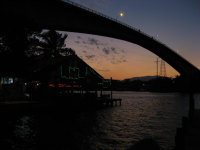
Dona and I arrived in Fronteras, also known as Rio Dulce (the same name as the river on whose banks it is located) about dusk after a long day. We'd traveled from Copan, Honduras, to Quirigua, Guatemala, by chicken bus and micro bus. We'd spent time at the ruins there, then traveled by more chicken busses and micro busses to the Rio. We were hot and tired, and tired of lugging all our stuff. We checked in to Hotel Backpackers; it was convenient, and not too pricey. After we got settled, we relaxed with dinner on the deck/dock and watched the sun go down behind the bridge across the river. The bridge is the highest in Central America, or at least it was when it was built; or at least that's the claim. It's somewhat of a tourist destination; every time I walk across it I encounter people getting their picture taken. Our dinner at Backpackers' was delicious; our room sucked. It was open on to the ceiling above about eight feet, as were all the surrounding rooms, so there was little privacy. The walls were simple 1 x material, or in places just fabric. We could hear the person in the space next to us typing away on his laptop, and I'm sure he could hear me reading "Three Cups of Tea" to Dona.
 |
| Bridge at Fronteras |
The next day we schlepped our stuff across the bridge to Bruno's, and stocked up on supplies. Chico picked us up and we headed down the river to Jennifer's, where Malakii is moored. We took a few detours on the way down, poking into some nooks and crannies of the Chacon Machaca to see the sights.
We had a great dinner with Jennifer, and Dona started getting used to life on a small boat. I took the saw over to Casey, glad to be offloading it but also pleased to have been able to help him out. My friends Manfred and Andrea had decided to sell their catamaran, and we watched Manfred take her out for a test sail with a potential buyer. They had built the boat themselves, then sailed her over from Europe, and she had been their home off and on for some time. They now own land next to Jennifer, have a little boy, and figured they aren't going to be doing much sailing for a while.
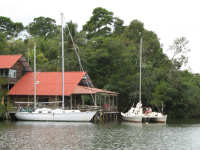 |
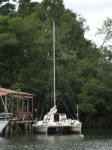 |
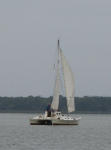 |
| Jennifer's house | Manfred and Andrea's catamaran |
After a day spent resting up and relaxing, we headed down the river. We got a late start, as I was trying to decide whether it made sense or not to leave based on the weather. We didn't have a lot of time, given Dona's return flight from Belize City, so I finally decided to head out in spite of less-than-ideal weather. You could wait forever for the "right" weather. We got to Livingston at 15:00. By the time we were checked out of Guatemala, it was 17:00. I didn't want to spend the night in Livingston; the rockin' and rollin' is a lousy introduction to sailing, so we headed out as the sun was setting. We didn't have a lot of wind, but we made it to the sea buoy that marks the start of the Rio Dulce bar before dark. Then the wind picked up a little and we made a steady three knots over to Cabo Tres Puntas.
The next morning we had a long, wet trip over to Punta Gorda, Belize, where we checked in and did some shopping. Towards the end the weather cleared, and at one point we had quite a few dolphins around us. Unfortunately, it was Sunday. By the time we were checked in it was after 5pm and the markets were closed. We spent a calm night anchored off Punta Gorda, then headed out early the next morning towards the Sapodillas. The wind was marginal and it's a long sail, so when the wind died about noon we motored for a few hours before it came back up.
I was planning on snagging the mooring buoy at Franks Cay, but as we approached I could see there was a catamaran on it. That turned out to be a good thing, as I later discovered the buoy is set in water too shallow for a keelboat. Instead, we continued north and anchored by NE Sapodilla, near where Dave and I had been the year before.
We spent the next day relaxing and exploring, wading around the cays, looking for critters and other interesting bits and pieces. We found new mangroves growing on the windward side of NE Sapodilla, establishing themselves despite the frequent battering of storm waves. They are one of the most important parts of these island ecosystems; without them, the islands would disappear over time. They do wonders to help dissipate the tremendous energy in storm waves, allowing the cay itself to build and stabilize behind them. We saw an Osprey and some Whimbrels. I've since learned that the Whimbrel is the widest ranging curlew, breeding in the arctic and migrating as far south as the southern tip of South America. We took the dinghy and motored over to Franks Cay, where we waded around picking up starfish and watching the bazillions of small fish hiding in the shallows, doing what little fish do and hoping not to become food too soon. We even found a deflated dive float, something we could use when we were snorkeling or diving from the dinghy.
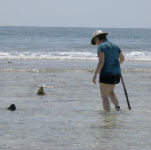 |
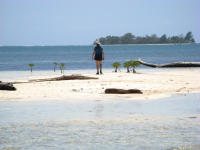 |
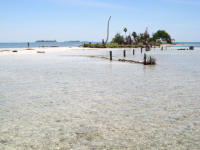 |
| Dona at NE Sapodilla | New mangroves | Mini-island at Franks Cay |
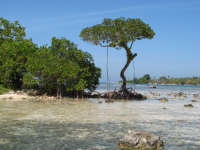 |
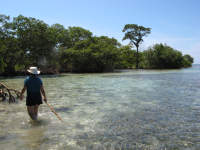 |
| Franks Cay | Dona wading shallows at Franks |
During our beachcombing we found a couple of coconuts, so we brought one back to the boat. There are at least two kinds of coconuts; one is easy to get into, and the other is not. The ones I find are always the hard to get into variety, so we didn't waste too much time trying. After chopping and prying the husk off with a machete, we drilled a hole in the ends to get at the liquid inside. It wasn't particularly good. I thought that was the milk, but it's only water. A coconut doesn't have any coconut milk. Coconut milk is made from the meat. Thick milk is made by squeezing and filtering the meat (think of a cider press). The squeezed meat is then soaked in warm water and squeezed one or more times again for thin milk. After getting the water out, we sawed the shell in half and flaked out the meat. It wasn't particularly good either, but then I'm not a big coconut fan. At least it looked right. If it was particularly nutritious I would cultivate a taste for it, but I don't think it is. We took some of the meat and ran it in through the blender with pineapple, yogurt and bananas, but that didn't make it taste any better, unfortunately.
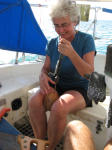 |
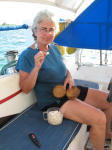 |
| Getting into a coconut | Coconut sampling |
Dona got her first taste of Caribbean snorkeling here. The snorkeling wasn't great, but we did see things and she got a chance to get used to her mask and snorkel. That evening, there was a lot of phosphorescence in the water. Squids?
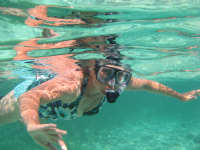 |
| Dona snorkeling |
We left NE Sapodilla fairly early in a light breeze, but we ran out of wind shortly afterwards. I was planning on going up to Queen Cays but because of the light wind and its direction, we headed over to Laughing Bird Cay instead. No one was there when we arrived, so we had the whole island to ourselves, a big surprise.
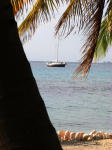 |
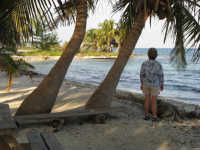 |
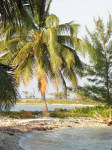 |
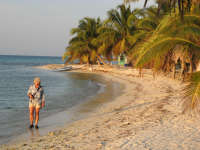 |
| Malakii at Laughing Bird Cay | Laughing Bird Cay |
We spent the next morning snorkeling. The water wasn't particularly clear, being stirred up from wave action. But we did see a good variety of fish.
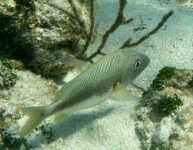 |
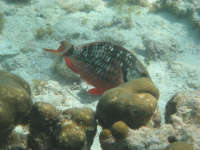 |
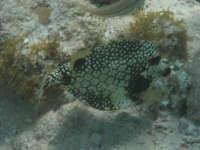 |
| Blue Striped Grunt | Stoplight Parrotfish | Smooth Trunkfish |
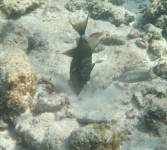 |
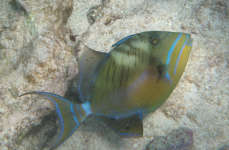 |
| Queen Triggerfish foraging; Puddingwife | Queen Triggerfish |
People were starting to appear by the boatload; Laughing Bird is the main snorkeling and diving destination for people vacationing at Placencia. So we decided to head further north. As we were sailing out, one of my dive booties I had draped over the rail to dry went overboard; they're pretty old, and the velcro closure straps I had used to secure them need cleaning. We did a quick stop loop and I snagged it with the boat hook. We sailed up to Lagoon Cays. There's a mooring ball there now, much to my surprise. We rowed around the lagoon looking for Manatees, but didn't see any. We did see a number of birds -- Osprey, Pelicans, and some others we couldn't identify. And always lots of small fish. The next time I'm there I think I should go for a dive and see if there's anything interesting in there. It's difficult to see much; the water is dark, and there's a mostly grass bottom.
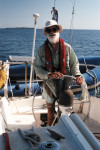 |
| Gary, Leaving Laughing Bird
|
Then we sailed up the east side of Douglas, Spruce, Norwal and Weewee Cays to Southwater Cay, where we anchored and did some more snorkeling. There was an open buoy, but I didn't use it because it was pretty far in and the wind was shifting to the north. I didn't want to be caught that close to the beach if the weather went sour. This was the buoy where Ian and Trudy and I provided entertainment for the locals last year, so I was intimately familiar with the surrounding bottom...
We took the dink ashore, and on the way saw a small Spotted Eagle Ray grousing around in the sand looking for mollusks. It was so shallow its wings were out of the water half the time. We also found a large school of what I think were bonefish circulating in a deeper hole in near shore. There was a nice heron standing on the remains of a destroyed dock just off the beach.
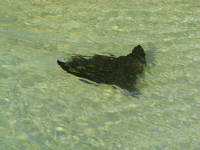 |
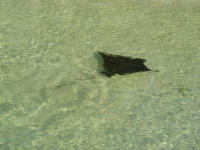 |
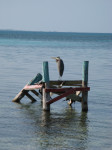 |
| Spotted Eagle Ray mollusking | Heron, Southwater Cay |
I got out the drum head I had purchased in Guatemala City and filed it down to fit on my banjo. It worked!
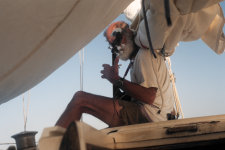 |
| Yea! Music
|
We went snorkeling several times; each time Dona got better at it. We saw a lot of cool fish.
Unfortunately, there was a norther coming our way, and Southwater isn't a very good spot to weather one. My friends Tom and Kris on Dragon Lady were holed up in Sapodilla Lagoon, so I decided to head over that direction. I had the hook up to about 30 feet, a scope of 1.5 for the 20 feet of water we were anchored in, when a Belizian fishing boat pulled up and asked if we had any extra large pulleys. I had a good supply of blocks I've accumulated and figured I could spare one, so I got one and held it up for them to look at. They said it looked good and motioned me to toss it to them, but I shook my head, afraid I'd miss. They put a young boy in a cayuco and let him out on a line to come over. I was afraid the line wasn't long enough to reach, so when he got close I gently tossed the block underhand, intending to land it in his cayuco... and missed. It hit the top of the gunwhale and bounced back into the water. Why the kid didn't jump for it, I don't know. I almost jumped in to get it as it sank only slowly and I could see it easily, but I had my self-inflating life vest and my glasses on, and I was worried about us dragging, It took a long time for anyone else to get a mask and get in the water, and they never did find it. I finally got another one, and this time the main guy came over and I handed it to him. By the time we were done with that fiasco we were dragging, but we pulled the anchor up and got under way without further excitement.
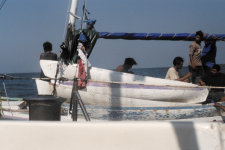 |
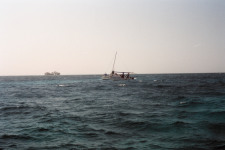 |
| Belizian Fishermen | Fishing boat |
We had a great sail over to Sapodilla Lagoon. In spite of it being a beat all the way we only had to tack coming down through the narrow slot in Blue Ground Range. The channel out the west side looked pretty scratchy in the clear water with coral heads everywhere, but we went through fine in fifteen feet of water. The wind steadily built, and by the time we turned into the Lagoon we were reefed down and flying. We put the hook down and settled in for the blow.
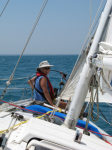 |
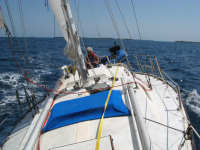 |
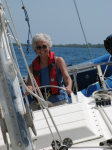 |
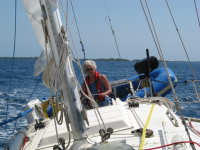 |
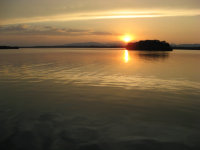 |
| Dona on bow | Dona sailing | Sapodilla Lagoon |
I had noticed that the batteries weren't charging when I ran the engine a few days before, so I took the opportunity of our layover in Sapodilla Lagoon to look into it. I found a broken wire going to the alternator and fixed it, which seemed to solve that part of the problem. But the starter battery wouldn't hold much of a charge; my success at resurrecting it was obviously only temporary.
We took the dinghy and explored the lagoon and some of the creeks feeding into it. The lagoon had a great population of herons and we enjoyed trying to sneak up on them for pictures. One of the creeks had been dredged into a straight channel for some reason; certainly not navigation, as it was barely a foot deep in places. Perhaps as a real-estate scam. In any case, it was fun to go up because the mangroves gave way to a mixed forest with pines and other types of trees.
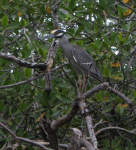 |
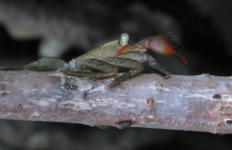 |
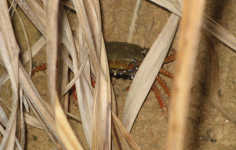 |
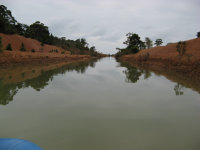 |
| Heron | Crab | Crab | Dredged and straightened creek |
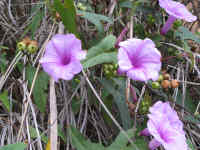 |
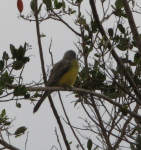 |
||
| Flower | Yellow bird... |
The next day we headed down to Placencia. Dragon Lady sailed down with us, so we got a few pictures of each other. I fished on the way down, hoping to get something we could have for dinner with Kris and Tom, but came up empty. So we ate out at a restaurant instead and treated ourselves to ice cream afterwards.
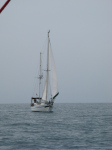 |
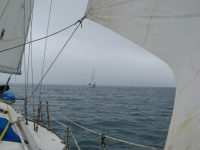 |
 |
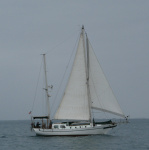 |
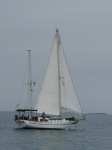 |
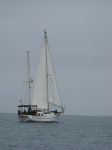 |
| Dragon Lady |
In the first picture below, I'm scurrying forward to start taking pictures of Dragon Lady. In the third picture, you can see a red piece of webbing attached to a yellow piece of webbing pulled at an angle towards me. The two pieces of webbing are the jacklines, run from near the bow to the stern. I clip my harness in to them when working on deck so I'll still be attached to the boat if I go overboard. I also carry a short webbing etrier (ladder) I can hook on a stanchion, jackline, or anything else handy to help climb back aboard in the event that happens.
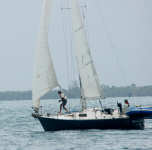 |
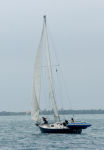 |
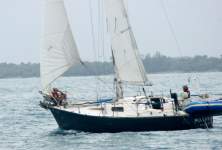 |
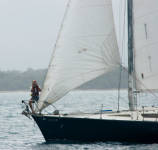 |
| Malakii |
The next day we left at the crack of dawn, headed north towards Colson Cays. The wind died mid-morning, and since it was 40 nm up there, We ran the iron genny for a few hours. The wind slowly came back and we flew the spinnaker for a bit. We came in to Colson in the dark, which is not too difficult as long as any boats in there have lights on. There were three other boats anchored there, a bit of a surprise given the weather. We continued on the next morning, sailing up past Alligator Cay and then we cut over east to Rendezvous.
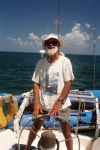 |
| On the way to Rendezvous
|
Anchoring at Rendezvous can be a bit tricky in a keelboat, as the water is fairly deep close in. We wanted to do some snorkeling, so we went a bit further north and anchored inside the reef. Then we took the dinghy down to Rendezvous to look around.
Rendezvous Cay is your prototypical desserted Caribbean isle, as depicted by hollywood. It's tiny, has about six palm trees, a palapa, and a manicured beach. It's frequented by cruise ship tenders who haul hordes of people out there for their Belizian snorkeling / sunbathing experience during their ten hour stay in Belize. We were fortunate; no one was there when we arrived.
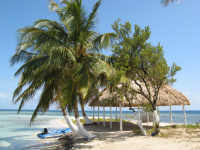 |
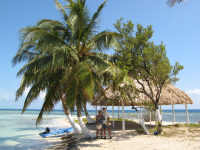 |
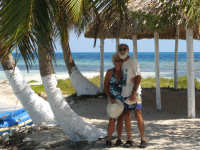 |
| Rendezvous Cay |
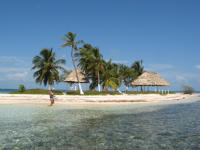 |
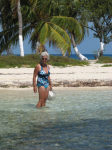 |
| Rendezvous Cay |
Then we took the dinghy back to the reef north of there and went snorkeling. We had a great time, following the edge of the reef as it curved around to the outside, where we got into a large school of Blue Tang and Doctorfish and saw a nice variety of others. We also found a Flamingo Tongue, a real treat.
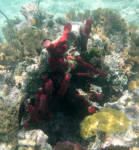 |
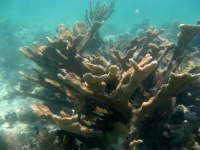 |
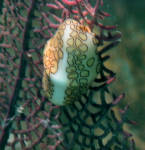 |
| Coral | Elkhorn Coral | Flamingo Tongue |
After lunch with watermelon for dessert, we sailed to Belize City. We anchored off the St. George Hotel dock, then walked around town. We stopped by Brodies Grocery, where I planned to buy out their stock of honey-roasted peanuts, a favorite of Jennifer's and mine. I always bring her a jar when I return from Belize. Alas, Brodies has quit carrying them. Another blow to wonderful food thanks to globalization. All they have now is crappy Planter's stuff. I checked a few other stores but couldn't find any.
In the evening we had a great dinner at the Harbour View Restaurant. In the morning we checked out some of the handcraft and art museums and stores, plus my favorite street vendor. Dona got a necklace from him; it was almost noon and his first sale of the day. He is one of the few vendors who makes his own stuff, which is one reason why I like him. We also found some Mayan looking stuffed animals and wooden painted fish jigsaw puzzles for her grandkids.
To show Dona what cruiseship-ville is like, we poked into the cruise ship "village" that is built on the wharf. Talk about paranoid. They do everything they can to shield people from the evils of a second world country -- despite the fact that first world ones have the same problems, often worse. As non cruise ship people (we walked in off the street, as opposed to off the cruise ship tender) we had no official "we're squeaky clean" plasticized I.D. card, so we had to give up some actual id (driver's license) which would be given back when we exited. All this just to get into a sanitized shopping mall, selling junk from china and "duty free jewelry." Everything on the street in Belize is duty free, but it makes for good marketing hype. To paraphrase P.T. Barnum, sucker gets off a cruise ship every minute. Anyway, it was an experience not to be missed, just to see what a warped view of another country cruise ship people get.
We stopped at the Parrot for a drink and nachos, then back to the boat to get Dona's stuff. Then we were off to the airport for her flight home.
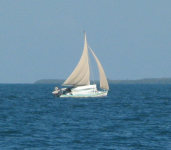 |
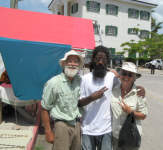 |
| Fishing boat | with the jewelry guy |
After I said good-bye to Dona at the airport, I picked up groceries, topped off my non-potable water, and headed back out. I had told Kris and Tom I'd try to rendezvous with them near Southwater, and head out to Glover's Atoll for a few days.